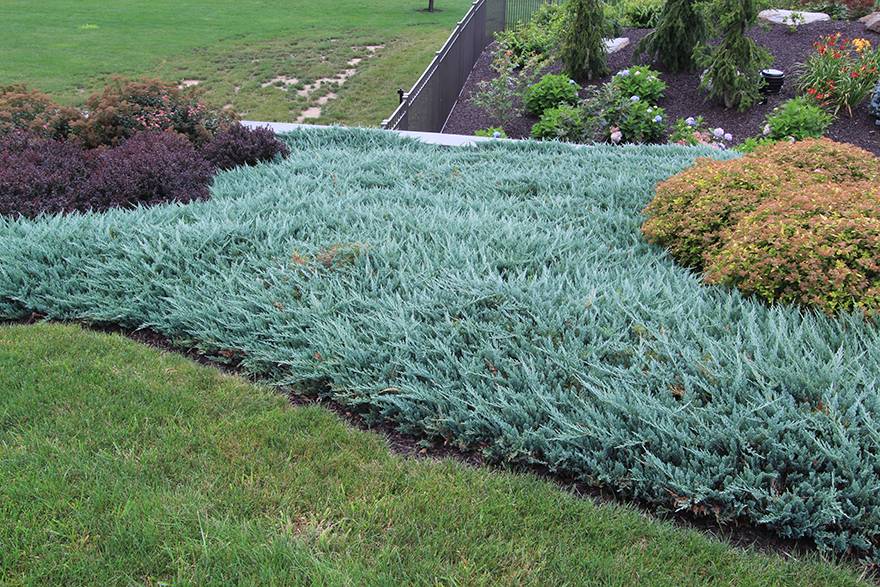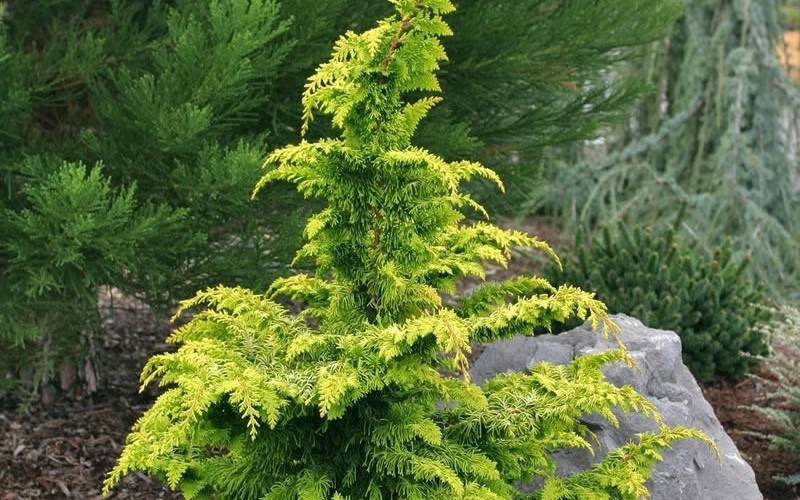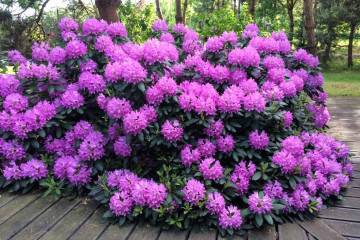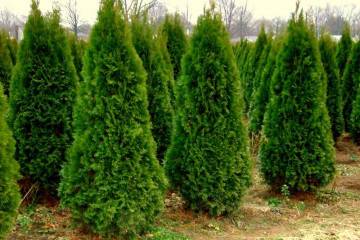Coniferous shrubs for the garden - the names of ornamental shrubs
Content:
The use of conifers for decorating personal plots is gaining momentum every year. This is due to the unpretentiousness in caring for them. Decorativeness and combination with any plantings play an important role. Evergreen beauties are suitable both for single plantings and as part of a flower bed or general landscape design of a summer cottage.
The use of ornamental coniferous shrubs in landscape design
Decorative varieties are used to decorate the plots. They are not as tall as wild ones, they are unpretentious to care for and have a more decorative appearance (the needles and branches are thicker). Most often, the following names of coniferous shrubs can be found in landscape design:
- juniper;
- Pine;
- spruce;
- thuja;
- yew;
- cypress.
Another unique feature of these plantings is the ability to create figures and unusual shapes to the crowns of shrubs. Thuja, junipers and common spruce are best suited for such experiments. Intricate shapes, geometric shapes, perfect balls - fantasy can make a unique design.
General rules of planting and care
When planning a flower bed with coniferous plantings, it is important to understand what dimensions the shrub will be after 5 years. The size of an adult plant depends on the selected species and growth method.
Conifers are not picky about the place of growth. They perfectly tolerate shade, partial shade and sunny places. But there are nuances of landings, depending on the lighting. In the shade, the needles grow more slowly, in sunny places on especially hot days, the greens must be protected, otherwise they will turn yellow. The place of growth must be final, transplanting is often fatal. Young seedlings are accepted quickly and actively grow, provided they are properly planted.
To plant a young bush, you need to prepare a place. A dug hole up to 70 cm deep is filled with drainage by a third. Broken brick, pebbles, sand are suitable as it (it is ideal to mix everything). The best soil for planting is a mixture of compost soil, sand and clay soil. When planting, it is important to leave the root collar above the soil level.
The diameter of the planting hole should be 3-5 times large in comparison with the earthen lump of the seedling. Since the roots are superficial, it is impossible to water under the bush from a hose with pressure, only along the edge of the planting pit.
The soil is mulched with pine bark or large sawdust. Mulch protects the planting from pests and weeds, and also retains moisture for a longer period. It is advisable to loosen the soil after each watering, but carefully so as not to damage the roots.
With the correct fit, further maintenance is not difficult.
- Watering is more necessary for young plantings to actively build up greenery. Watering is necessary in small portions and only dry soil. Waterlogging entails a number of problems, so it is better not to top up than to overflow.
- In the autumn, it is important to moisturize the soil well in order to protect the roots from freezing.
- Fertilizers are needed for mature plants in the spring. The best food for needles is compost. Manure and nitrogen fertilizers are not suitable.
- In winter, the roots are protected with a thick layer of mulch (5-10 cm). The branches often break from snow and ice, so they need to be shaken off. During periods of snowfall, it is advisable to tie long shoots (especially important for thuja, cypress).
- In the spring, pruning is carried out to remove all damaged branches, as well as to give the desired crown shape.
Evergreens rarely get sick, usually they pick up fungal diseases. In winter, during periods of thaw, the needles rot. Preventive treatment in the fall will protect the evergreen garden.
Types of coniferous shrubs
When choosing needles for landscaping a summer cottage, you need to focus on the size of an adult shrub, its growth method and color. Conifers perfectly coexist with all garden plantings, so the choice depends on the decorative qualities of the bush.
Mountain Pine Goulden Glow
The dwarf perennial shrub is interesting in that its long needles turn yellow in winter. In winter, it plays with contrast against the background of other plants. Dimensions are small, an adult bush will be 1.3 m high and 1.8 m wide. Pine is light-loving, frost-resistant and unpretentious to the soil.
Spruce Maxwelli
A small tree up to 1.5 m high. The cone-shaped crown type reaches 2 m in diameter. Spruce grows slowly, with an average annual growth of up to 3 cm. The color of the needles is light green. It can become the center of a flower bed or a slide, or be used in group evergreen plantings. These spruce trees grow well even in the Urals.
Juniper Blue Chip
The shaggy branches of this handsome man are green-blue in summer, and become burgundy-lilac in autumn. A low-growing (up to 40 cm) variety of juniper can grow up to two meters in width. Ground cover junipers often create the backdrop for an entire flower bed or rock garden. Look great around water bodies.
Cypress Aurora
Emerald dwarf shrub with a golden tint grows up to a meter. Annual growth of 5 cm, rapidly fills the dense crown and looks decorative from the moment of disembarkation. A feature of the care is regular and moderate watering.
Jacobsen cross-pair microbiota
The undersized shrub will remain small for a long time, as it grows very slowly. It grows more in breadth than in height. The needles are thick and disheveled, reminiscent of algae. In summer, the greens are juicy green, in autumn the ends of the branches turn brown.
Mountain Pine Dwarf
A densely stuffed pine tree at a young age has a rounded shape. In a more mature form, it stretches into a wide pyramidal shape, reaching a height of 2 m and a width of up to 3 m. The needles are shiny, bright green. Perennial looks great in the center of the flower bed, on rock gardens and slides. When landing in the south of Russia, it prefers sandy soil.
Spruce Glauka Globoza
The dwarf tree stands out due to its blue-white needles and a dense crown. The average size is 2 m in height and width. It grows slowly, at a young age it has a spherical shape, over the years it stretches into a pyramid. Due to its size, it looks better in single compositions.
Juniper Chinese Mint Julep
It is a sprawling and bright shrub with long, dense branches. The height of the bush 10 years after planting reaches 1.5 m. The diameter of the spreading juniper is 3.5 m. It is used in design as a ground cover shrub or cut in the form of a pyramid.
Dull cypress Rashahiba
A pyramidal loose shrub with an unusual color. Young leaves have a lemon hue, over time they turn green. The height of an adult cypress is 2 m.It is used to decorate group plantings, as well as in single compositions. Suitable for the climate of the Perm region.
Yew Elegantissima
The wide shrub reaches up to 1.5 m in diameter and 1 m in height. The needles are light yellow, in the autumn they turn white. It has advantages among conifers, as it lends itself well to crown molding and tolerates close proximity to large trees.
You can create a beautiful flower bed at a summer cottage with the participation of dwarf shrubs. Conifers look spectacular against the background of each other, are combined with neighbors in the flower beds and are unpretentious in care. Curly pruning of the crown and decorativeness of plantings throughout the year will allow you to create a zest of the garden.



















